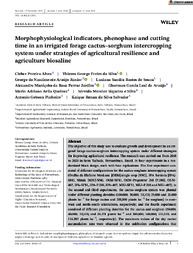Morphophysiological indicators, phenophase and cutting time in an irrigated forage cactus–sorghum intercropping system under strategies of agricultural resilience and agriculture biosaline.
Morphophysiological indicators, phenophase and cutting time in an irrigated forage cactus–sorghum intercropping system under strategies of agricultural resilience and agriculture biosaline.
Author(s): ALVES, C. P.; SILVA, T. G. F. da; ARAÚJO JÚNIOR, G. do N.; SOUZA, L. S. B. de; JARDIM, A. M. da R. F.; ARAUJO, G. G. L. de; QUEIROZ, M. A. A.; SILVA, S. M. S. e; PINHEIRO, A. G.; SALVADOR, K. R. da S.
Summary: The objective of this study was to evaluate growth and development in an irrigated forage cactus–sorghum intercropping system under different strategies for improving agricultural resilience. The research was carried out from 2018 to 2020 in Serra Talhada, Pernambuco, Brazil, in four experiments in a randomized block design, each with four replications. The first experiment consisted of different configurations for the cactus–sorghum intercropping system (Orelha de Elefante Mexicana [OEM]-single crop [SNG], IPA Sertânia [IPA]-SNG, Miúda [MIU]-SNG, OEM–SF11, OEM–Progenitor 288 [P.288], OEM–467, IPA–SF11, IPA–P.288, IPA–467, MIU–SF11, MIU–P.288 and MIU–467); in the second and third experiments, the cactus–sorghum system was planted under different planting densities (100,000; 50,000; 33,333; 25,000 and 20,000 plants ha?1 for forage cactus and 200,000 plants ha?1 for sorghum) in east–west and north–south orientations, respectively; and the fourth experiment consisted of different planting densities for the cactus and sorghum (50,000; 40,000; 33,333; and 28,571 plants ha?1 and 200,000; 160,000; 133,333; and 114,285 plants ha?1, respectively). The maximum values of the dry matter accumulation rate were observed in the cultivation configurations that contained the OEM clone and at the highest densities. The different cultivation configurations affected the duration and number of phenophases. The cutting time increases as the planting density increases (50,000 and 100,000 plants ha?1) and when the OEM clone is used.
Publication year: 2024
Types of publication: Journal article
Unit: Embrapa Semi-arid Region
Observation
Some of Embrapa's publications are published as ePub files. To read them, use or download one of the following free software options to your computer or mobile device. Android: Google Play Books; IOS: iBooks; Windows and Linux: Calibre.
Access other publications
Access the Agricultural Research Database (BDPA) to consult Embrapa's full library collection and records.
Visit Embrapa Bookstore to purchase books and other publications sold by Embrapa.

